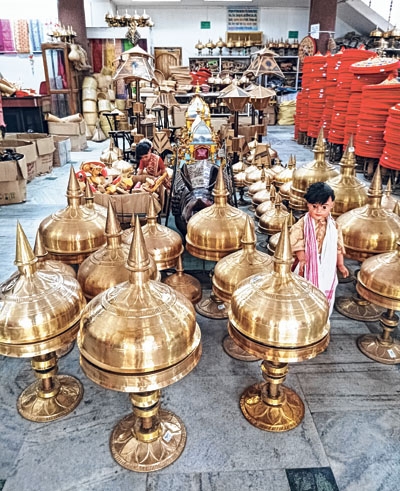Xorai – Assam’s cultural symbol
|

S Balakrishnan
Xorai is one of Assam’s traditional and auspicious cultural symbols. Its benevolent omnipresence can be felt in the State in various sizes – gigantic to miniature. The Xorai or Horai has been in use since ages in both religious and social functions. Xorai is a two-part brass/bell metal item with a conical dome-like top and a shallow circular tray with a stand at the bottom. Xorai is of great value to the Asomiya (Assamese people).
Xorai is an offering tray, to put it simply. As an offering tray of ‘prasad’ to the gods, xorai is placed in the altar (‘namghar’). The bottom portion of Xorai (called bota / sarai) is used as an offering tray of tamul-paan (betel leaves & betel nuts) to visitors as a sign of welcome. As such, it plays an important role in all social & family functions/rituals/ceremonies like weddings, etc. In modern usage, Xorai is also used as a decorative symbol besides being presented as a gift to persons of honour while felicitating them. I hope I would be presented with a huge Xorai by Asomiya for this well researched article (pirated from the Net)!
The Xorai is manufactured out of bell metal or brass. Hajo (near Guwahati) and Sarthebari (in Barpeta District) are the two important traditional production centers of brass and bell metal products in Assam. Metal craft is the second thriving handicraft of Assam after the bamboo craft. Xorai has a smooth surface with subtle shine and is either plain or may have linear and floral patterns. Competition in the metal craft of Assam has now risen from Moradabad in Uttar Pradesh. Hailed as the ‘Pital Nagar’ (Brass City), Moradabad is threatening Assam’s traditional metal craft centres. So there is a ‘Vocal for Local’ movement urging Asomiya to buy only the local metal craft items. This is similar to the alarming flooding of cheap Chinese items of all sorts in the Indian market.
The Ahom Buranji (the chronicles and manuscripts of Ahom kingdom)records that during Lengdon’s (Lord of Thunder) wedding with Nang-Hun-Hpa, he sent a present of a Xorai with betel leaves and areca nut. So it might be an Ahom tradition but it is not conclusive;maybe they adopted it from other communities. Perhaps from the trading community of Sutias who themselves might have absorbed it from out of their Tibetan/Burmese trade connections.
Whatever be it, the hoary Xorai/Horai is a distinct wealth of Asomiya culture along with the other traditional symbols like the Jappi (the hat) and Gamosa (the scarf). Naturally, therefore, I was tempted to buy the smallest version of Xorai for Rs.350. This despite my wife’s warning not to accumulate any curioas our showcase is already bursting with such alluring curios carefully collected during our various trips across Incredible India!
Ther writer can be reached at [email protected]

